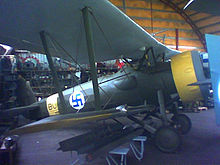| Type 105 Bulldog | |
|---|---|
| Role | Fighter |
| Manufacturer | Bristol Aeroplane Company Filton, Bristol |
| Designed by | Frank Barnwell |
| First flight | 21 January 1928 |
| Introduced | 1929 |
| Primary users | Royal Air Force Spanish Air Force Finnish Air Force Royal Australian Air Force |
| Number built | 443 (including prototypes and licence built) |
Contents
|
Design and development
In September 1926, the Air Ministry stated a need for a single-seat fighter capable of operating in day and night-time conditions; to be armed with two 0.303 in (7.7 mm) Vickers machine guns and to be powered by an air-cooled radial engine. This requirement was laid down in Specification F9/26. The Bulldog was designed by Frank Barnwell, the Chief Designer of the Bristol company, (who had served as a Captain in the British Army during the First World War), as a private venture to meet the requirements of this specification. The prototype Bulldog, the Bulldog Mk. I first flew on 17 May 1927.[1] After initial consideration of all the types entered to meet the specification, the Bulldog and the Hawker Hawfinch were selected for more detailed evaluation.[2] While the Bulldog's manoeuvrability and strength were praised by the RAF,[3] it initially had poor spinning recovery properties and was therefore fitted with a lengthened rear fuselage. In this form, it was declared the winner of the competition, having slightly superior speed[4] and was easier to maintain,[4] and required fewer changes to produce an operational aircraft than the Hawfinch.[2]The full-production Bulldog came in the form of the Mk.II, which had a modified structure but in every other respect was identical to the original Bulldog; having two 0.303 in (7.7 mm) Vickers machine guns; a capacity for four 20 lb (10 kg) bombs; a 450 hp (340 kW) Bristol Jupiter radial engine; giving the Bulldog a maximum speed of just under 180 mph (290 km/h) and a range of 300 mi (480 km). The aircraft then entered production in 1928, entering service the following year, and becoming, during the early 1930s, the most widely used aircraft in the RAF. It was cheap to maintain and thus, at a time of defence budget constraints, was the more preferable option to any other competitors. The Mk. IIA was again virtually similar to its predecessor, though it had a new Jupiter engine and a strengthened structure.

A Bristol Bulldog preserved at the RAF Museum, Hendon
Operational history
The Bulldog never saw combat with the RAF, though during the Abyssinia Crisis of 1935-36, Bristol Bulldogs were sent to the Sudan to reinforce Middle East Command. Douglas Bader, better known for his Second World War actions, lost both of his legs when his Bristol Bulldog crashed while he was performing unauthorised flying Aerobatics at Woodley airfield near Reading.In 1936, Latvia, keen to replace its elderly Bulldogs with more modern aircraft, sold eleven Bulldogs to Basque nationalist forces fighting the Spanish Republicans in the Spanish Civil War, remaining in use until the Battle of Santander.[5] 19 Bulldogs also saw combat as part of the Finnish Air Force during the Winter War against the Soviet Union, which began in 1939. The Bulldogs fought well against their Soviet opponent, gaining six kills by five pilots for the loss of one of their own,[6] the types shot down being two Polikarpov I-16s and four Tupolev SBs,[6] both of which were quite superior in terms of technology compared to the Bulldog. In fact, the very first aerial victory of Finnish Air Force was achieved by a Bulldog piloted by SSgt Toivo Uuttu on 1 December 1939,[7] over an I-16.[6] The Bulldogs were used in advanced training during the subsequent Continuation War against the Soviet Union.[6]
Variants
- Bulldog I
- Single-seat day and night fighter prototype; 2 built by Bristol Aeroplane Co.
- Bulldog II
- Single-seat day and night fighter version. Powered by a 440 hp (330 kW) Bristol Jupiter VII radial piston engine; 92 built by Bristol Aeroplane.
- Bulldog IIA
- Single-seat day and night fighter version. Powered by a 490 hp (370 kW) Bristol Jupiter VIIF radial piston engine; 268 built by Bristol.
- Bulldog IIIA
- Interim aircraft. Only two aircraft were built by Bristol.
- Bulldog IVA
- Single-seat day and night fighter version. Powered by a 640 hp (480 kW) Bristol Mercury radial piston engine; 18 built by Bristol.
- Bulldog TM (Type 124)
- Two-seat training version; 59 built by Bristol.
- "J.S.S.F."
- Two aircraft license-built by Nakajima Aircraft Works, Japan.
Operators

Bristol Bulldog preserved at the Hallinportti Aviation Museum museum.
- Royal Australian Air Force
- No. 1 Squadron RAAF - Bulldog Mk. IIA
- No. 2 Squadron RAAF - Bulldog Mk. IIA
|
|
Specifications (Bulldog II)
Data from Bristol Aircraft since 1910 [8]
General characteristics- Crew: 1
- Length: 25 ft 2 in (7.67 m)
- Wingspan: 33 ft 10 in (10.3 m)
- Height: 8 ft 9 in (2.67 m)
- Wing area: 307 ft² (28.5 m²)
- Empty weight: 2,205 lb (1,000 kg)
- Max takeoff weight: 3,490 lb (1,586 kg)
- Powerplant: 1× Bristol Jupiter VII radial piston engine, 440 hp (328 kW)
- Maximum speed: 155 kn (178 mph, 287 km/h)
- Service ceiling: 29,300 ft (8,930 m)
- Guns: 2 × 0.303 in (7.7 mm) Vickers machine guns
- Bombs: 4 × 20 lb (9 kg) bombs
 Unknown
Unknown









0 komentar:
Post a Comment